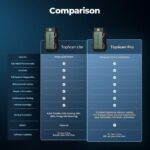As the lead developer of the Fixd Obd2 App, I wanted to address some common questions and provide insights into why our app functions the way it does, especially when compared to cheaper, basic OBD2 scanners. Many users are curious about the necessity of features like online connectivity and account logins, and it’s important to understand the underlying technical reasons.
The world of OBD2 and CAN (Controller Area Network) is far more intricate than it initially appears. Those inexpensive $15 scanners you find online, along with their accompanying apps, typically offer very limited capabilities. They often rely on small, rudimentary code databases, often scraped from wikis, and usually only support single protocols and modules within a vehicle’s system. These basic tools generally lack advanced features such as error filtering or sophisticated inner-frame parsing, which are crucial for accurately collecting data from a wider range of vehicles, especially those with more complex or less common configurations. Furthermore, they often employ static, generic scripts that are applied across a limited set of diagnostic addresses, regardless of the specific vehicle.
The real complexity emerges when you move beyond basic engine diagnostics and start to interact with other vehicle modules like airbags, TPMS (Tire Pressure Monitoring System), seatbelts, and the transmission. These modules often communicate using different protocols, requiring the diagnostic tool to perform mid-stream protocol switching and negotiation. Different makes, models, and years of vehicles also require specific baud rates and communication nuances. The challenge escalates dramatically when you go beyond simple Mode 3/7/9 hex-to-code parsing.
Storing the vast array of vehicle-specific variations and diagnostic procedures directly within a mobile app is simply not feasible. The sheer volume of data required for comprehensive coverage across all vehicle types would result in an app size exceeding multiple gigabytes. Adding to this complexity, some diagnostic commands and procedural steps are proprietary and licensed by vehicle manufacturers, making them inaccessible without significant financial investment.
To overcome these limitations, the FIXD OBD2 app employs a different approach. Instead of storing an enormous, outdated database on your phone, our app intelligently scans your car to assess its specific communication capabilities. Based on this assessment, it then downloads the most up-to-date and customized command list tailored to your particular vehicle. We have a dedicated team of engineering interns who continuously work on specific modules – for example, airbag systems in 2008-2012 Toyota vehicles. They develop and deploy test scripts, gather diagnostic data, create custom parsers, and release regular updates to our system. Because these scripts are refreshed and downloaded every time you log in, your FIXD app effectively gains new diagnostic capabilities each time it’s launched, often without requiring a traditional app update.
This dynamic, server-based approach necessitates API calls, which in turn require network access and authentication tokens to ensure data security and integrity. While we do cache these scripts locally on your device to improve performance and reduce data usage, an initial network connection is needed to obtain them in the first place.
Regarding user logins, we understand the frustration this can sometimes cause. As a startup that began with a small team, our entire infrastructure was initially built around user accounts. We are currently undergoing a significant refactoring process to streamline the signup experience, including implementing auto-account generation, which will simplify this process considerably in the future. However, these are complex changes that require time to implement thoroughly.
In the interim, we are pleased to announce the introduction of “Offline Mode,” available in version 7.1.1 and later. If you have successfully logged into the FIXD app at least once and allowed it to cache the necessary data, you can now access a reduced functionality mode even without an active internet connection. You may see an “OFFLINE MODE” warning banner to indicate the limitations. It’s important to note that network access is not required for Live Data once you are logged in and the app has launched. You can monitor live gauges in your vehicle without needing a continuous internet connection.
However, for scanning and reading diagnostic trouble codes (DTCs), a network connection remains necessary for the reasons explained above – to access the latest vehicle-specific diagnostic scripts and parsing logic. We have implemented a network error prompt that automatically saves your scan data. So, if you initiate a scan, lose internet connectivity mid-scan, and then regain connection, the app will prompt you to “Retry,” allowing you to resubmit the raw data for parsing and continue the scan seamlessly. This ensures you don’t lose your diagnostic progress due to temporary network interruptions.
Finally, let’s address FIXD Premium. This optional subscription service offers advanced features that incur ongoing operational costs for us. For instance, our “confirmed fixes” feature relies on data from a third-party company that compensates mechanics for their repair data. We pay this company per API call to access this valuable information. Similarly, our issue forecasting feature, which involves issue aggregation, machine learning analysis, and other sophisticated backend processes, also carries significant recurring costs. These premium features simply could not be offered without a subscription model. We are continually working to improve our messaging and clearly differentiate between free and premium features within the app to ensure transparency for our users.
Thank you for your valuable feedback. We are committed to continuously improving the FIXD OBD2 app and have exciting new features planned for both free and premium users in the coming year. We encourage you to stay tuned for updates and experience the evolving capabilities of FIXD.
